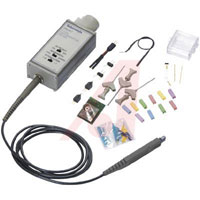P6247產(chǎn)品概述
Passive Probe, 1.5 m Cable Length, 150 MHz Bandwidth
Introduction
Active Differential Probes allow you to view differential signals. Differential signals are signals that are referenced to each other rather than to ground. While a matched pair of single-ended probes can be used, a true differential probe typically gives higher performance, providing high CMRR, broad frequency range, and minimal time skew between inputs. Differential signaling transmits data over two complementary wires. The signal pair is routed together to a receiver, which subtracts them from each other to recover the original signal. Differential signaling is becoming more common as rates increase. Differential signaling eliminates common mode noise, It also reduces the need for a common reference voltage between the transmitter and the receiver against which the signal is compared to determine its logic level, eliminating some signal integrity issues such as "ground bounce".
When your signal must be measured differentially, Tektronix has a range of differential probing solutions to fit your application. While a matched pair of single-ended probes can be used (see P6135A below), a true differential probe typically gives the highest performance, providing high CMRR, broad frequency range, and minimal time skew between inputs. For high-voltage floating applications, see the High Voltage Probes.
Ideal for design verification of disk drive read, channel electronics and timing analysis for troubleshooting ground bounce problems associated with high-speed logic. They can also be used for pulse shape or cross talk compliance testing of highspeed communication signals.


 Datasheet
Datasheet